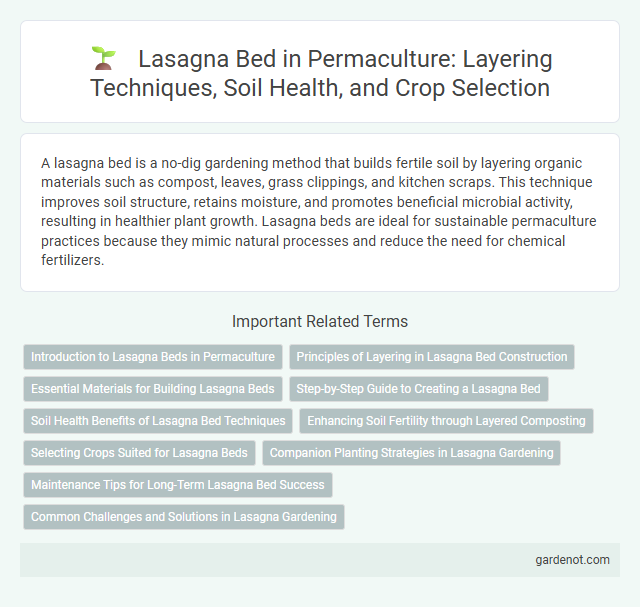A lasagna bed is a no-dig gardening method that builds fertile soil by layering organic materials such as compost, leaves, grass clippings, and kitchen scraps. This technique improves soil structure, retains moisture, and promotes beneficial microbial activity, resulting in healthier plant growth. Lasagna beds are ideal for sustainable permaculture practices because they mimic natural processes and reduce the need for chemical fertilizers.
Introduction to Lasagna Beds in Permaculture
Lasagna beds in permaculture utilize layered organic materials to create nutrient-rich, no-dig garden beds that improve soil fertility and water retention. These beds combine compost, mulch, straw, and kitchen waste to mimic natural forest soil layers, promoting healthy microbial activity and plant growth. This sustainable method reduces weed growth and soil erosion while enhancing biodiversity within the garden ecosystem.
Principles of Layering in Lasagna Bed Construction
Lasagna bed construction follows the Permaculture principle of layering organic materials to create nutrient-rich, self-sustaining soil. Each layer alternates between carbon-rich brown materials like dried leaves or straw and nitrogen-rich green materials such as grass clippings or kitchen scraps, enhancing microbial activity and moisture retention. This method mimics natural forest soil development, promoting healthy root growth and improving overall garden fertility.
Essential Materials for Building Lasagna Beds
Essential materials for building lasagna beds include layers of organic matter such as cardboard or newspaper to suppress weeds, compost or well-rotted manure to provide nutrients, and a mix of brown (carbon-rich) materials like dried leaves, straw, or wood chips for structure and aeration. Green (nitrogen-rich) materials such as grass clippings, vegetable scraps, and coffee grounds accelerate decomposition and nutrient cycling. Adequate moisture retention can be ensured by incorporating soil or finished compost on the top layer, promoting healthy root growth and microbial activity in the permaculture garden.
Step-by-Step Guide to Creating a Lasagna Bed
Creating a lasagna bed involves layering organic materials to build nutrient-rich, no-dig garden beds. Start with a base of cardboard or newspaper to suppress weeds, then alternate layers of green materials like vegetable scraps and grass clippings with brown materials such as leaves and straw. Water each layer thoroughly to promote decomposition, allowing the bed to settle and break down into fertile soil ideal for growing healthy plants.
Soil Health Benefits of Lasagna Bed Techniques
Lasagna bed techniques enhance soil health by layering organic materials that improve soil structure, increase microbial activity, and boost nutrient availability. The decomposition of diverse layers of carbon-rich and nitrogen-rich materials creates a rich, fertile environment that retains moisture and supports beneficial soil organisms. These dynamic processes result in improved soil fertility, aeration, and long-term sustainability for permaculture systems.
Enhancing Soil Fertility through Layered Composting
Lasagna beds enhance soil fertility by layering organic materials such as kitchen scraps, cardboard, straw, and garden waste, creating nutrient-rich compost directly in the garden. This method mimics natural decomposition, gradually breaking down layers to improve soil structure, moisture retention, and microbial activity. The continuous supply of diverse organic matter promotes healthy plant growth and sustainable nutrient cycling in permaculture systems.
Selecting Crops Suited for Lasagna Beds
Selecting crops for lasagna beds requires prioritizing plants that thrive in nutrient-rich, layered compost environments. Leafy greens, herbs, and shallow-rooted vegetables like lettuce, spinach, and radishes excel due to their minimal soil disturbance and quick growth cycles. Incorporating nitrogen-fixing legumes such as beans and peas enhances soil fertility and supports sustainable permaculture practices.
Companion Planting Strategies in Lasagna Gardening
Lasagna gardening utilizes companion planting strategies to enhance soil fertility and pest control by layering complementary plants such as nitrogen-fixing legumes alongside nutrient-demanding vegetables. Strategic pairing of plants like basil and tomatoes improves growth and flavor while deterring harmful insects, maximizing overall garden productivity. These synergistic relationships within lasagna beds support sustainable, low-maintenance permaculture practices by promoting biodiversity and natural soil enrichment.
Maintenance Tips for Long-Term Lasagna Bed Success
Regularly monitor moisture levels to keep the lasagna bed evenly damp, preventing both drying out and waterlogging. Incorporate layers of organic mulch to suppress weeds and retain soil nutrients, enhancing the bed's fertility over time. Periodically add fresh organic matter, such as compost or fallen leaves, to replenish decomposed layers and sustain microbial activity essential for healthy plant growth.
Common Challenges and Solutions in Lasagna Gardening
Lasagna gardening often faces challenges such as poor drainage, slow decomposition, and nutrient imbalances within the layered organic materials. Addressing these issues involves incorporating coarse materials like straw or wood chips at the base for improved drainage, regularly turning and moistening the layers to accelerate decomposition, and adding balanced composted materials to enhance soil fertility. Effective management of these factors results in a productive, nutrient-rich lasagna bed that supports healthy plant growth.
Lasagna bed Infographic

 gardenot.com
gardenot.com